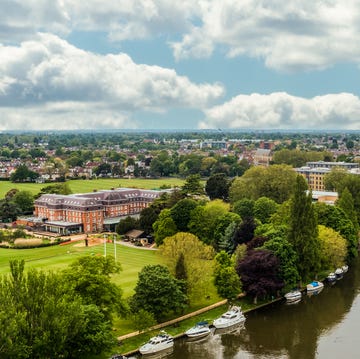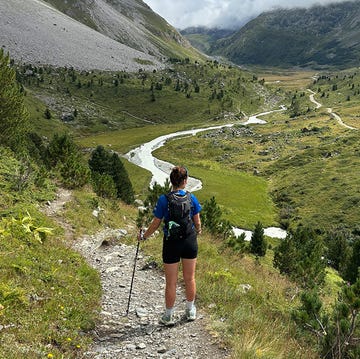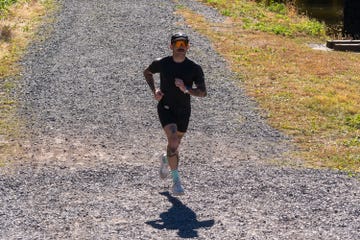You don’t have to board a plane to take your running to wild and wonderful places – from big days out to long weekends and epic, once in a lifetime experiences, here’s our guide to the UK’s very best running routes so you can plan your next adventure.
Around Tresco, Isles of Scilly
- Distance: 6 miles (10K)
- Ascent: 200m (660ft)
An archipelago of contrasting islands, including uninhabited Samson, windswept Bryher, bustling St Mary’s and sub-tropical Tresco, Scilly’s pale sandy beaches, clear seas and relaxed, outdoorsy vibe make it a superb adventure destination. The trail that circumnavigates Tresco – the second-largest island – is a great way to explore its variety of landscapes, flora and fauna. Starting at the quay, a clockwise loop visits Cromwell’s Castle and the granite outcrops and wild heathland along the exposed and rugged north coast. Sand and shell beaches line the eastern shore, while in the south stands the Benedictine abbey with its famous gardens – well worth a post-run visit. A few times each year, it’s possible to cross the sandy stretch between Tresco and neighbouring Bryher on foot. For more information, click here.
The Monsal Trail, Peak District National Park
- Distance: 8.5 miles (13.7km)
- Ascent (starting from Bakewell): 400m (1,310ft)
This former railway line runs through the Peak District National Park between the pretty town of Bakewell and Chee Dale, close to Buxton. Suitable for bikes, buggies and wheelchairs, it’s a fantastically accessible, family-friendly run that also feels like an adventure. Dark tunnels, dramatic scenery and café stops dot the way, and it’s easy to link up with other trails including the Limestone Way and Pennine Bridleway for a longer day out. Highlights include the Headstone Viaduct, which strides across the River Wye at Monsal Dale affording fantastic views of the surrounding limestone landscape; atmospheric Litton Mill; and the towering crags that line the route’s western end. For more information, click here.
What everyone's reading
Loch Ossian from Corrour station, Scottish Highlands
- Distance: 9 miles (14km)
- Ascent: 85m (280ft)
Remote Loch Ossian lies on the north-eastern edge of Rannoch Moor, to the east of Ben Nevis. Accessible only on foot, bike or train, Corrour station is an hour from Fort William and three from Glasgow. While our run starts at the station, the 7.5-mile circuit from the Youth Hostel on the loch’s shores has become a legendary running challenge since former hostel manager, Tom Rigg, completed it in 49 minutes in 1977. A logbook of those who have run the loop in under an hour is kept at the hostel. Stunning mountain scenery awaits on atmospheric forest trails and open moorland with sweeping views across the water. Corrour Station House serves delicious, local food to hungry adventurers, and even supplies picnics. For more information, click here.
Around Derwent Water, Lake District National Park
- Distance: 10 miles (16km)
- Ascent: 550m (1,800ft)
This popular trail around beautiful Derwent Water is best run clockwise to fully appreciate the spectacular views of the surrounding fells. Setting out from the Moot Hall in Keswick, famous in fell running circles as the start/finish point of the Bob Graham Round, the route heads down the eastern lakeshore, passing Broomhill Point with great views across to Catbells. The 30m-high cascade of Lodore Falls and the 'Chinese bridge' over the River Derwent at Borrowdale await at the lake’s southern end, along with gorgeous views north to Skiddaw and Blencathra. Returning up the wooded western shore, the trail crosses the suspension bridge at Portinscale before returning to Keswick. For more information, click here.
Isle of Portland Circuit, Dorset
- Distance: 12.5 miles (20km)
- Ascent: 510m (1,670ft)
The Isle of Portland is a limestone outcrop linked to mainland Dorset by the shingle spit of Chesil Beach. The scars of centuries of quarrying and military presence lie alongside stunning natural geological features and rare wildlife, including dazzling wildflowers, which light up the meadows and verges in spring and summer. This run loops the island, starting at Chesil Beach and following the Jurassic Coast section of the South West Coast Path throughout on runnable quarry tracks with some steep but short climbs and descents along the way. From Portland Bill at the southern tip of the island, views stretch from the Isle of Wight in the east to Prawle Point in South Devon in the west. Finish at the Beehive café and bakery in Fortuneswell. For more information, click here.
The Cambridge Ring
- Distance: 18.6 miles (30km)
- Ascent: 65m (230ft)
This varied route encircles most of the city of Cambridge, staying within the A14 and M11. With a great mix of green spaces and interesting historical and architectural sites, along with plenty of good café stops, it’s a great way to explore some of Cambridge’s lesser-known gems. Starting and finishing at The Green Dragon pub in Chesterton, close to Cambridge North station, the run visits Grantchester Meadows, Byrons Pool, Trumpington Meadows, Hobson’s Brook, Nine Wells, Cherry Hinton Hall, East Barnwell Nature Reserve, Coldhams and Stourbridge Commons, Cambridge Science Park and Eddington. It’s not waymarked, so you’ll need to navigate, but comprehensive directions can be found here.
Nine Edges Challenge, Peak District National Park
- Distance: 20 miles (32km)
- Ascent: 900m (2,950ft)
The official Nine Edges Challenge takes place each September, linking up the Peak District’s iconic gritstone edges between Ladybower Reservoir and the Robin Hood pub near Birchen. Raising funds for Edale Mountain Rescue team, participants can choose to walk, run or climb. If you prefer to plan your own adventure, it’s also a fantastic anytime challenge, setting out from Ladybower and running past Derwent Dam and up to Lost Lad and Back Tor before crossing Derwent Edge and Stanage Edge. Upper and Lower Burbage follow, with a stretch through the pretty National Trust Longshaw Estate to reach Froggatt, Curbar and Baslow edges. A wooded trail connects to Gardom’s and Birchen Edge, from where it’s a kilometre from the final trig point to the pub. For more information, click here .
Surrey Three Peaks Challenge
- Distance: 23 miles (37km)
- Ascent: 1,060m (3,480ft)
Based on the classic Three Peaks Challenges (National, Yorkshire and Welsh), the Surrey version ticks off three of the county’s most famous hills: Box Hill, Holmbury Hill and the county top, Leith Hill. Taking in parts of the North Downs Way, Leith Hill Greenway, Mole Gap Trail, Pilgrim's Way and Greensand Way, as well as crossing Box Hill’s famous stepping stones, the route is easily reached from Box Hill & Westhumble station. If you ‘re still feeling fresh at the finish, Leith Hill Tower’s 78 spiral steps await, along with a welcome café in the base of the tower. Click here for more information.
Kielder Lakeside Way, Northumberland
- Distance: 26 miles (42km)
- Ascent: 890m (2,900ft)
Looping around Northumberland’s remote Kielder Water, the waymarked Lakeside Way, home to the annual Kielder Marathon, boasts 26 miles of gloriously uninterrupted trail. The undulating route runs through spectacular scenery, taking in switchback sections, crags and the vast Kielder Forest, as well as the imposing castle, dam and viaduct. Keep an eye out for art installations as you run, as well as the local wildlife, including ospreys, water voles and red squirrels. There are several refuelling options along the way, located in Kielder village and along the southern shore of the lake – the north shore is more remote, and you’ll need to be self-sufficient for its full length. For more information, click here.
Yorkshire Three Peaks, Yorkshire Dales National Park
- Distance: 24 miles (38.6km)
- Ascent: 1,600m (5,000ft)
The three Pennine peaks of Pen-y-Ghent (694m), Ingleborough (723m) and Whernside (736m) stand at the head of Yorkshire’s Ribble Valley. Linking the three peaks in under 12 hours is a popular walking challenge; running allows you to stop and admire those stunning summit views across the Yorkshire Dales. Starting at Horton-in-Ribblesdale station, the traditional direction loops anti-clockwise, climbing first to Ingleborough, then running north through Chapel-le-Dale to Whernside, and finally heading south past the Ribblehead Viaduct to join the Pennine Way over Pen-y-Ghent before returning to Horton. The annual Three Peaks Race – known as ‘the marathon with mountains’ – is held each spring, with 2025 marking its 70th anniversary. Click here for more information.
Long weekends
Welsh 3,000s Challenge, Eryri National Park
- Distance: 30 miles (48km)
- Ascent: 4,200m (13,800ft)
Eryri National Park boasts 15 (sometimes counted as 14, or even 16) peaks over 3,000ft (914m). Linking these has long been a challenge for fell runners and hillwalkers, tackling the tough terrain, technical climbs and descents, and exposed mountain environments. While the traverse itself is 24 miles, adding the distance to the start and finish brings it closer to 30. It’s an enjoyable adventure over a weekend, with road access at Ogwen valley. Those chasing a 24-hour completion start from the summit of Yr Wyddfa (Snowdon) at dawn. The route heads north to Nant Peris, followed by the Glyder and Carnedd mountain ranges, finishing at Foel Fras, the final summit, where the clock stops. This is a tough, weather-exposed challenge demanding good mountain skills, so it’s a great idea to join a guided event such as those offered by Eryri-based RAW Adventures, who offer 1- and 3-day options (raw-adventures.co.uk/adventures/welsh-3000s). The 14 Peaks Ultra is also an exciting new addition to the Skyrunning calendar, held in June by Apex Running. Click here for more information.
Across Knoydart, Scottish Highlands
- Distance: 15/26 miles (24/42km)
- Ascent: 930m/1,318m (3,051ft/4,324ft)
The wildly remote Knoydart peninsula lies on the west coast of the Scottish Highlands between Loch Nevis and Loch Hourn. Covering around 55,000 acres, the peninsula boasts four Munros and the village of Inverie, home to about 120 people. Inverie also has a shop, tearoom, pub and accommodation, plus boats back to the ‘mainland’ – cut off from the road network, Knoydart can only be accessed on foot or by boat. Starting at Kinloch Hourn (15 miles/24km run, only accessible via a 22-mile road) or Glenfinnan (longer at 26 miles/42km but accessible by train), this run crosses vast stretches of pathless wilderness and takes most people a couple of days, overnighting at one of several bothies – always take a tent in case the bothies are full. For more information, click here.
London Royal Parks
- Distance: 28 miles (45km)
- Ascent: 235m (771ft)
A grand urban adventure, this run links up all 10 of London’s Royal Parks. Starting from Bushy Park and following the River Thames to Richmond Park, the route winds through open green spaces before crossing the river into Chelsea. Brompton Cemetery is next – a lesser-known Royal Park – followed by Kensington Gardens, Hyde Park and Green Park. Passing Buckingham Palace, you’ll reach St James's Park, Royal Park number seven. This is about halfway, near the centre of the city and close to St James’s Park and Westminster underground stations if you want to split the route over a weekend. From here the route heads through Westminster and Victoria Tower Gardens to Regent's Park. A final crossing of the Thames brings you to Greenwich Park – the 10th park that completes the challenge. A great anytime adventure that’s easily accessible by public transport, there are also several organised charity events that take on the Royal Parks Challenge.
Ullswater Skyline, Lake District National Park
- Distance: 35 miles (48km)
- Ascent: 3,050m (10,000ft)
Inspired by lockdown viewing of America’s Tahoe Rim Trail, the team from Freedom Racing established the Ullswater Skyline, which takes in the rugged watershed encircling Ullswater in the Lake District, packing in around 3,000m (10,000ft) of elevation. Starting and finishing on Pooley Bridge, the route runs anticlockwise, following the Ullswater Way over Gowbarrow to Dockray, then over the fells of Watermillock Common to Sticks Pass. Other tops include Helvellyn, Fairfield, Red Screes and High Street, returning along the ridgeline of tops to Pooley Bridge. The run can be split into two days by stopping at the A592 at Kirkstone Pass, 20.5 miles in. Full details on the route, including registering a completion or FKT, can be found here
Exmoor Coast Bothy Adventure, North Devon
- Distance: 41.5 miles (67km)
- Ascent: 3,200m (10,500ft)
Starting from Ilfracombe on the western edge of Exmoor National Park, this run follows the South West Coast Path along the full length of Exmoor’s undulating coastline to Minehead, with 3,200m of ascent. Characterised by steep-sided combes, sandy beaches and rocky headlands, it’s a varied run, with fascinating geology, gorgeous coastal views, and plenty of pubs and cafes along the way. Highlights include dramatic Heddon Valley, home to the Hunter’s Inn – an ideal refreshment point; neighbouring Lynton and Lynmouth; Foreland Point; and the distinctive rock formations at the atmospheric Valley of Rocks. The National Trust has four bothies along this stretch of coast, offering basic, bookable accommodation for up to four people. To split the run into two days, the Foreland Point bothy is at 20 miles. For a three-day itinerary, there are bothies at 12 miles and 18 miles, and a campsite in Porlock at 30 miles (48km).
Dartmoor Crossing by train
- Distance: 42 miles (68km)
- Ascent: 1,824m (5,984ft)
The recently reopened train station at Okehampton, on the northern edge of Dartmoor, enables a full traverse of the National Park between here and Ivybridge in the south. There’s a vast choice of different routes across the moor, but much of the area to the south of Okehampton is a military live firing range, so check firing times before setting off if you’re venturing this way. Alternatively, follow the Two Moors Way from Ivybridge to Chagford, then the Dartmoor Way to Okehampton. Responsible wild camping, pitching from dusk until dawn and leaving no trace, is permitted on some areas of Dartmoor, allowing a truly off-grid adventure. On the Two Moors Way, Pupers Hill after 10 miles and Kestor Rock at 28.5 miles are both good wild camp spots, while Chagford has a range of shops, cafes and accommodation. For a wild camping map, details of live firing and a wealth of other information including accommodation and refreshment stops, click here.
Forest of Avon Community Forest Path (Green Man), Bristol
- Distance: 45 miles (72km)
- Ascent: 1,148m (3,766ft)
Originally devised as a waymarked walking route linking the green spaces around Bristol on footpaths, tracks and rural lanes, the Forest of Avon Community Forest Path is now best known for the Green Man Challenge, with organised summer and winter ultras and an anytime challenge. Completion of the route earns the title of ‘Woodwose’. The varied route offers glimpses into hidden woods and valleys, climbs to discover great views of the Mendip Hills and the Severn Estuary, and visits Ashton Court, Blaise Castle and the Clifton Suspension Bridge. Parts of the trail follow the Bristol & Bath Railway Path at Warmley, the Two Rivers Way, and the River Avon Trail at Keynsham. Splitting the route into two or three days is straightforward, with train access at Keynsham, Bristol Parkway and Sea Mills connecting to central Bristol. For more information on the route, click here.
The Moray Coastal Trail, Scottish Highlands
- Distance: 45 miles (72km)
- Ascent: 489m (1,604ft)
The Moray coastline to the north-east of Inverness is dotted with stunning sandy beaches, dramatic sea cliffs, coastal formations and pretty settlements. The Moray Coastal Trail offers a wonderfully runnable way to explore, starting inland at the country town of Forres and heading for the coastline at Findhorn, famed for its eco-community. The intermittently waymarked but generally easy-to-follow trail winds through the forested reaches of vast Burghead Bay and scales the clifftops between Burghead and Lossiemouth. Further on, Spey Bay is a great place to spot dolphins, from where a string of attractive former fishing villages leads to the finish of the trail in Cullen. There’s a train station in Forres, and buses back from Cullen. To split the route over two or three days, accommodation is available in Burghead at 13 miles, Lossiemouth at 22 miles and Buckie at 36.5 miles. For more information, click here.
Glasgow to Edinburgh Canal
- Distance: 60 miles (97km)
- Ascent: 603m (1,978ft)
Designed by celebrated engineer John Smeaton in 1790, the Forth & Clyde canal crosses the Scottish Lowlands at the narrowest part, providing a route for sea-going vessels between the Firth of Clyde and the Firth of Forth. Closed in 1963, the canal now offers a route for runners, walkers, cyclists and paddlers, linking the two great cities of Glasgow and Edinburgh with the impressive Falkirk Wheel boat lift bridging the 35-metre vertical gap between the Forth & Clyde and Union canals. This route runs station to station, following the towpaths of the two canals from Glasgow through Bonnybridge, Falkirk, Linlithgow, Broxburn and Ratho to finish in Edinburgh. Falkirk, at 27 miles, where there’s also a train station makes an obvious stop-off point if you’re splitting the run over two days. If you’d prefer to complete the challenge as part of an organised event, GB Ultras’ G2E Ultra takes place in October.
Isle of Wight Coast Path
- Distance: 70 miles (112km)
- Ascent: 1,460m (4,791ft)
Two different routes circumnavigate the Isle of Wight – one for cyclists, which follows the island’s quiet roads, and the other for pedestrians, linking footpaths and lanes and staying closer to the sea. As a running adventure, it’s hard to beat: well waymarked and packed with nature, history, views, pubs and cafes. The route visits the chalk sea stacks of The Needles and Alum Bay with its many-coloured sandstone cliffs; fossil-strewn Compton Bay and Yaverland Beach; rolling downland at Tennyson and Culver Downs; and quiet, wildlife-rich estuaries and wetlands. There’s also a great choice of accommodation in the island’s towns and villages, including Victorian seaside resort Ventnor, overlooking the Channel, and Sailing mecca Cowes. To run the loop over three days, a shorter first day of about 16 miles finishes at Yarmouth. Day 2 takes you to Sandown at 33.5 miles – the halfway point if you’re splitting into 2 – with about 20 miles left for Day 3. For more information, click here.
South Wales Traverse, Bannau Brycheiniog National Park
- Distance: 72 miles (116km)
- Ascent: 5,200m (17,000ft)
Formerly known as the Brecon Beacons Traverse, this tough challenge visits 31 600m (2,000ft) summits in the Carmathen Fans, Fforest Fawr, Central Beacons and Black Mountains areas of the Bannau Brycheiniog, totalling 5,200m of ascent. It was officially launched as a 24-hour challenge in 1984, after being completed by Derek Fisher and Andy Lewsley the previous year in 21 hours 24 minutes. The start is at Pen Rhiw-wen in the west of the National Park, heading eastwards to the finish at the ruins of Llanthony Priory. The route crosses the wild and featureless Fforest Fawr, the spectacular scalloped Carmarthen Fans, Pen-y-Fan – the highest and best-known peak in the area – and its neighbouring summits, finally entering the distinctive Black Mountains area with its long, finger-like ridgelines separated by curving valleys. Although envisaged as a 24hr challenge, the route works brilliantly over a long weekend, splitting well into thirds at the easiest road access points – the A470 at Storey Arms and the A40 near Crickhowell. For more details, including maps, summit lists and completions, click here.
Capital Ring, London
- Distance: 126km (78 miles)
- Ascent: 1,044m (3,425ft)
A shorter alternative to the 150-mile London Loop, the Capital Ring links up many of London’s urban and suburban green spaces, all within a 10-mile radius of Big Ben. Opened in 2005, it crosses the Thames at Richmond in the west and Woolwich in the east, visiting among many other places Crystal Palace Park, Syon Park, Horsenden Hill, Highgate Woods, Eltham Palace, Olympic Park, Finsbury Park, and Walthamstow and Hackney Marshes. A team of Ramblers volunteers, the Ring Rangers, monitor all sections of the Ring to ensure the route is properly maintained for the public to enjoy. The official start of the route is the Woolwich foot tunnel, but being circular it can be started or finished at almost any point, with excellent public transport links and accommodation options throughout. Click here for more information.
Once in a lifetime
Bob Graham Round, Lake District National Park
- Distance: 66 miles (106km)
- Ascent: 8,230m (27,000ft)
First completed in 1932 by Keswick hotelier Bob Graham to celebrate his 42nd birthday, and immortalised by Richard Askwith’s book Feet in the Clouds, the Bob Graham Round is a circuit of 42 of the highest peaks in the Lake District. Starting and finishing at the Moot Hall, Keswick, notable peaks include Skiddaw, Blencathra, the Langdale Pikes and Scafell Pike. To become a member of the Bob Graham Club, runners must complete the Round in under 24 hours, but it’s also an immensely enjoyable route to undertake over a few days, with fine weather and daylight to fully appreciate the magnificent vistas. The Bob Graham is traditionally split into five sections with accessible road crossings at Threlkeld, Dunmail, Wasdale and Honister. If you’re not planning a 24hr attempt aim to complete one or two of these sections per day over a weekend.
West Highland Way, Milngavie to Fort William
- Distance: 96 miles (151km)
- Ascent: 3,688m (12,100ft)
Scotland's first long distance route, and still its most popular, the WHW runs from Milngavie on the outskirts of Glasgow north to Fort William at the foot of Ben Nevis. It’s a route of wonderful variety, from the pastoral landscapes of the Campsie Fells, past vast Loch Lomond, and on into the increasingly rugged and towering Highlands. It crosses the wilderness of Rannoch Moor and skirts wildlife-rich Loch Leven, eventually traversing Glen Nevis to reach Fort William. Well-waymarked throughout and avoiding the summits, there’s plenty of runnable ground, although some stretches are remote and exposed to the weather. The popular West Highland Way Race – one of the world’s oldest ultras – takes place each summer. The route splits well over a few days. For a four-day itinerary, stop at Rowardennan (27 miles), Tyndrum (53 miles) and Kingshouse (72 miles). Click here for more information.
South Downs Way National Trail
- Distance: 100 miles (160km)
- Ascent: 3,800m (12,600ft)
Lying within easy reach of London, with many points accessible by train, the South Downs Way follows ancient paths and droveways along the chalk escarpment of the South Downs between Winchester and Eastbourne. An appealing century in distance, and pairing runnable ground with beautiful scenery and points of interest, it’s a popular route for races. Centurion Running’s SDW100 is part of the Gran Canaria World Trail Majors series and Western States Endurance Race qualifier. Highlights include Old Winchester Hill, showcasing history from the Mesolithic to WW2; the mile-long Devil’s Dyke; the huge carved hill figure of Long Man of Wilmington; and the Seven Sisters chalk cliffs. To run the route over four days, stop-off points with accommodation and refuelling supplies are at Buriton (24.5 miles), Amberley (76.5km) and Lewes (75 miles). Click here for more information.
Cotswold Way Kings and Queens
- Distance: 102 miles (164km)
- Ascent: 3,300m (10,827ft)
Tracing the undulating limestone escarpment of the Cotswold Hills from Chipping Campden to Bath, the Cotswold Way combines steep climbs to airy hilltops with equally steep descents into pretty towns and villages. Inspired by the Highland Kings Ultra, which combines running a long way with luxury overnights, the leg-sapping nature of the Cotswold Way pairs perfectly with the area’s many classy hotels and houses. Great options to split the miles include the Lygon Arms or The Fish in Broadway (6 miles); Ellenborough Park at Cleeve Hill (23.5 miles); The Painswick in Painswick (48 miles) or the National Trust’s Newark Lower Lodge at Wootton-under-Edge (70 miles). Descending from the hills into the Georgian splendour of Bath at the finish, you’re welcomed with a wealth of accommodation options – and the Thermae Bath Spa to soothe those weary limbs. Click here for more information.
Isle of Anglesey Coastal Path (Ring O’ Fire), North Wales
- Distance: 135 miles (210km)
- Ascent: 4,174m (13,695ft)
The trail that loops the coastline of Ynys Môn, the Isle of Anglesey, travels through a great variety of coastal landscapes – an adventure through the island’s fascinating geology and diverse mixture of wildlife habitats. With its official start point at St Cybi’s Church in Holyhead, easily reachable by train, the Isle of Anglesey Coastal Path takes in farmland, coastal heath, dunes, saltmarsh, foreshore, cliffs and pockets of woodland. Take in the views to Ireland’s Wicklow Mountains from the summit of Holyhead Mountain, watch seabirds and porpoises from South Stack lighthouse and sea cliffs, and pass the Menai Suspension Bridge and Britannia Bridge. The Ring O’ Fire Ultra tackles the full loop non-stop (ringofire.co.uk), but we recommend a five day adveture, stopping at Rhosneigr (30 miles), Llanfairpwll (61 miles), Moelfre (91 miles) and Cemaes (120 miles).
The Hebridean Way, Outer Hebrides
- Distance: 156 miles (252km)
- Ascent: 3,140m (10,301ft)
Starting at Vatersay, in the south of the Outer Hebrides archipelago, and island-hopping its way north to the Butt of Lewis, the Hebridean Way is a grand adventure. The full route takes in 10 islands, six causeways and two ferry crossings, traversing rugged hills and moorland and tracing the wild Atlantic coastline – keep your eyes peeled for otters and white-tailed eagles. The warmly welcoming islanders are as much a part of the journey as the running, with plenty of places to rest, refuel and restock along the way. Many residents speak Gaelic as their first language, and traditions and culture are wonderfully distinct from anywhere else in Britain. We recommend a six-day adventure, overnighting at Daliburgh (27 miles), Liniclate (54.5 miles), Lochmaddy (81 miles), Seilebost (104 miles) and Scaladale (127.5 miles). For more information, click here.
Coast to Coast Path (Wainwright’s C2C)
- Distance: 192 miles (309km)
- Ascent: 8,000m (26,247ft)
Traversing the country from the Irish Sea at St Bees in the west to the North Sea at Robin Hood’s Bay in the east, England’s original Coast to Coast path was conceived by Alfred Wainwright. The waymarked route weaves through three National Parks, visiting towns and villages and exploring diverse landscapes, from the lakes, fells and dales in the west to the rugged moorland in the east. Ourea Events’ Northern Traverse tackles the full distance in one go, but as a self-devised adventure at your own pace, there are many places to refuel and recharge along the route. It’s traditionally divided into sixteen sections for walking: seven in the Lake District and Cumbria, three in the Yorkshire Dales, two in the Vale of Mowbray and four in the North York Moors, and these can easily be combined for running. Baggage transfer services are also available if you don’t fancy carrying all your kit. Click here for more information.
South West Coast Path
- Distance: 630 miles (1,014km)
- Ascent: 35,050m (115,000ft)
Tracing the coast from Minehead on the edge of Exmoor in Somerset to Dorset’s Poole Harbour, the South West Coast Path is an epic adventure through vastly differing landscapes. Starting along the rugged Exmoor coast in Somerset, the route moves into Devon and then reaches the vast sandy bays at Bideford and Bude, continuing through arty St Ives. As the trail enters West Penwith, it becomes increasingly remote, with long stretches still feeling wonderfully wild. It extends to mainland England’s most southerly point at Lizard, passing through Cornwall’s coastline, dotted with beaches, coves, headlands, and pretty villages. From there, it leads into the rolling South Hams, giving way to East Devon’s red sandstone and pebble beaches, and finally arrives at the fossil-strewn Jurassic coastline around the Isle of Purbeck. Walkers typically take seven or eight weeks to complete the path, while runners may take less than half this. Dave Phillips’ supported record stands at 10 days 8 hours 24 minutes, while Sarah Perry holds the women’s and overall self-supported record at 13 days, 11 hours and 31 minutes, booking accommodation and refuelling from shops along the way. For more information, click here.











































